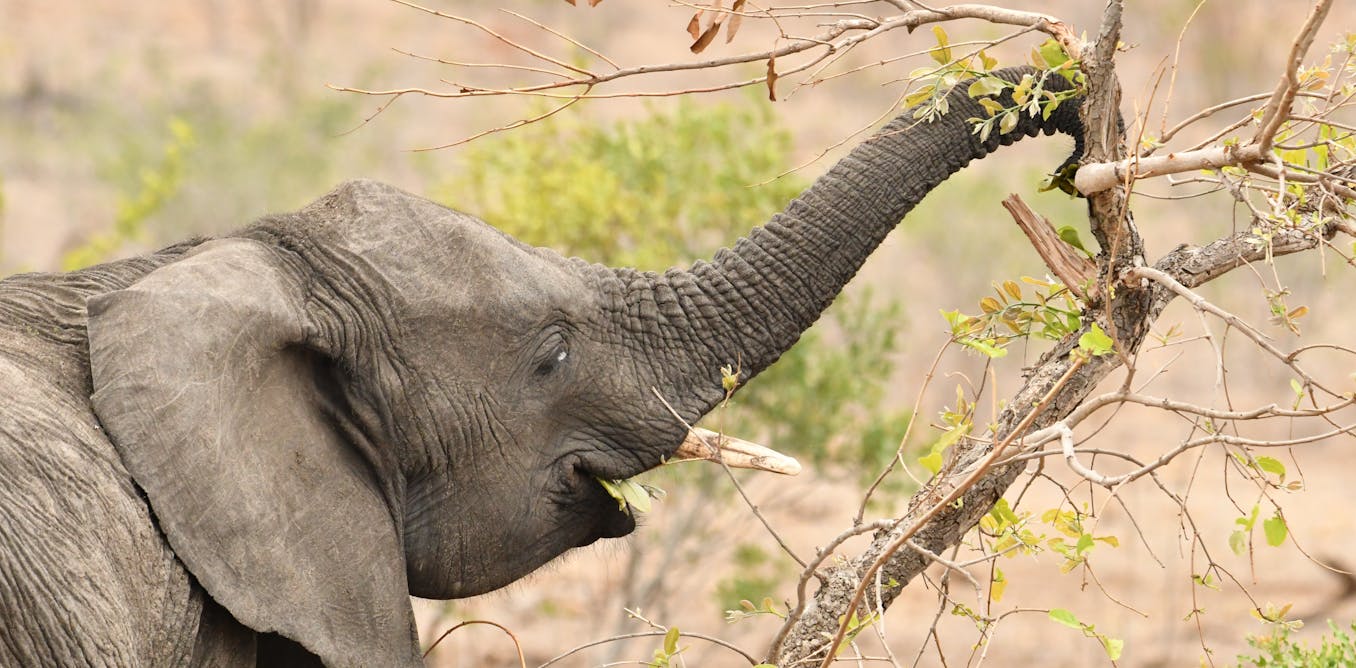[ad_1]
Elephants are known for their intelligence, strong social bonds, and good memories. But do they communicate to show real intention? A new study suggests they do. The research showed that elephants gestured to ask for food when a person was around and that they kept gesturing when they didn’t receive all the food. These are signs that the elephants are trying to communicate with intention.
We spoke to lead author Vesta Eleuteri, a PhD candidate, to learn more about what this means and why it matters.
Why did you study how elephants use gestures to communicate?
Most of the research on elephant communication is on their calls and chemical signals, likely because of their extraordinary hearing and smell. How elephants communicate with gestures is comparatively less studied. But there are descriptions of elephants using many different body movements and displays in different contexts, which suggests a key role of gestures in elephant communication.
But whether elephants gesture intentionally to others to communicate goals in mind has not been systematically explored before. My colleagues and I study the cognition and communication of animals to understand how complex cognitive skills evolved, which is what this article is based on.
In our study led by the University of Vienna and in collaboration with the University of St Andrews, the University of Portsmouth and City University of New York, we show that semi-captive elephants use many different gestures intentionally to ask a human to give them apples (their goal).
We found that the elephants used 38 different gesture types intentionally. The elephants kept gesturing when they only got half the apples (only partially reached their goal), while they changed gestures when they got no apples (did not reach their goal), both key behaviours to establish intentional use.
Why is it important to know whether their communication is intentional?
The ability to intentionally communicate goals in mind using a variety of gestures might help elephants navigate their complex social lives. By showing that semi-captive elephants gesture intentionally to humans using many different gesture types, our study builds on the evidence that this ability is not unique to primates, but that it has repeatedly emerged during evolution.
Here we consider intentionality as “goal-directed intentionality”, which is the ability to communicate goals we have in mind to others. This was in the past considered to be a unique human skill. Today we know that all the other apes and even some other primates (although in a less flexible way) communicate intentionally using over 70 different gesture types to communicate many different goals in mind. Some examples include gesturing for things like “come here”; “give me that”; “groom me”.
Read more:
Whose turn is it? The question is at the heart of language and chimpanzees ask it too
In non-primates, this intentionality was shown only in a few animals, from guppy fish to Arabian babblers. But typically this was done with one or two gestures and for specific goals, like “follow me”.
Elephants are distantly related to humans in evolution. We last shared a common ancestor with them over 100 million years ago. But, like apes, they are highly intelligent and live in complex societies where they have many different types of relationships (from kin to allies, friends and strangers). Also, there are descriptions of elephants using many different body movements and displays during many different contexts. These include when they greet, affiliate, play with each other or even when they travel together.
What gestures did the elephants use, and how do you know they were on purpose?
The elephants in semi-captivity often reached their trunks or swung them back and forth towards the human or the tray with apples. This made it clear they were communicating that they wanted the apples.
To know whether the elephants were using their gestures intentionally, we applied the behavioural criteria first created to study the development of intentional communication in human infants. These are: audience directedness, persistence and elaboration.
Signallers should use gestures when there is a recipient and appropriately according to whether he/she is looking or not (audience directedness). For example, if the recipient is not looking at them, they should use tactile gestures instead of visual gestures that the recipient would not see.
After gesturing, signallers should wait for the recipient to react and, if the recipient does not react as they wanted, they should keep gesturing (persistence) or change gestures (elaboration) to clarify what they wanted.
I can make an example. If I want to ask you to pass me the salt (my goal), I first should consider whether you are looking at me and, if you are, I may reach my hand towards the salt (audience directedness). If you don’t react or pass me the wrong thing, like the pepper, I should keep gesturing (persistence) or should change gesture by, for example, pointing towards the salt to clarify I wanted the salt from you (elaboration).
You worked with semi-captive elephants; do wild elephants act the same?
We and many other elephant experts have observed wild elephants gesturing apparently intentionally to each other (and even to us!) many times in the field. Nonetheless, we cannot confirm their ability to gesture intentionally merely from our observations. Science is there to systematically test with data the intuitions or feelings we get from observations.
Whether wild elephants use the same gestures we observed in this semi-captive group is an interesting question that needs to be explored. The same goes for assessing if different elephant groups or populations use different gestures. Based on previous descriptions, wild elephants should use, intentionally, a few of the gestures we found (trunk reaches or swings) but maybe they don’t use some of the “more creative” ones like the “blow leaf in the air” our elephant Pfumo had fun using.
Read more:
Spotted hyenas all sound different when they call – they can tell friend from foe
What’s next for your research?
We want to systematically test whether wild elephants gesture intentionally to each other, describe the repertoire of their intentional gestures and the goals (meanings) they use these gestures for (they may say to each other: “travel with me”, “move away”, “stop that”). We have thousands of videos collected in two elephant populations in South Africa that I am video coding for gestures and their intentional use.
It will take time to define the repertoire and meanings of elephant intentional gestures. But we hope to someday do this and to compare the gestures of different populations to understand if elephants may have different “gestural languages”.
Read more:
When a hippo honks, here’s what it could mean – to another hippo at least
Studying animal communication offers “a window” into our own language, into our minds, because it allows us to understand what, if anything, makes language unique. Showing that animals have so much in common with us makes people empathise more with them and care more about them, which is important for their conservation.
Read more:
Bottlenose dolphins smile at each other when they play — new study reveals how and why
Most importantly, studying animal communication is crucial because we can understand animals better and, if we know them better, we can take better measures to safeguard them.
![]()
Vesta Eleuteri is affiliated to the University of Vienna and receives funding from the Austrian Science Fund (FWF) under the grant "DK Cognition and Communication 2": W1262-B29 (10.55776/W1262).
[ad_2]
Source link



